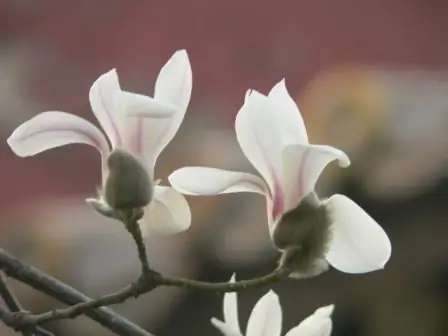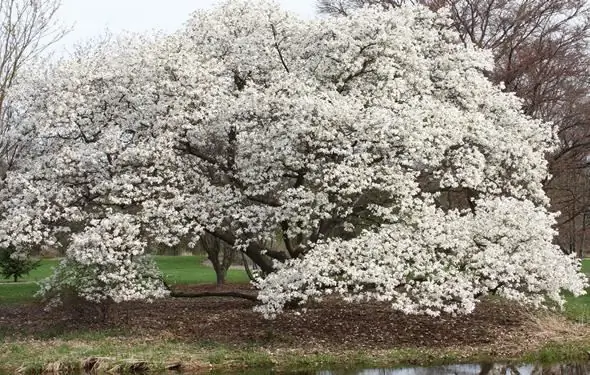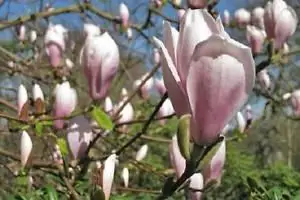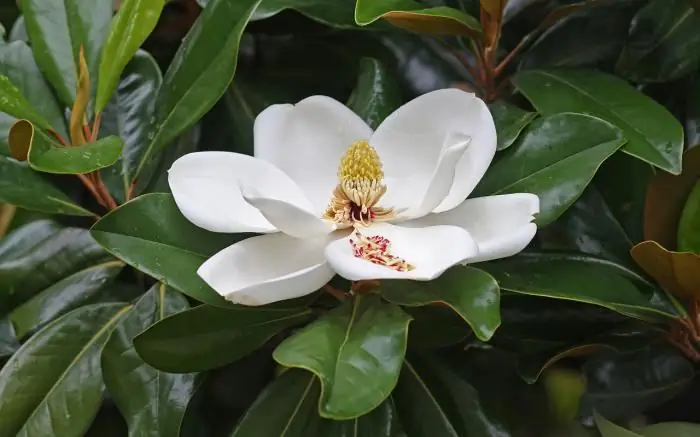Practically every tree people have adapted to use for their own purposes. Some give him fruit, others give him wood. But magnolia grandiflora (photos of it are presented in the article), a tree that is already 140 million years old, offers nothing to a person except beauty.

Magnolia has more than seventy species. Some of them are evergreen, others shed their leaves. They can grow in the form of a tree and a tall bush. In the wild, distributed in America, East Asia, Indonesia. In our area, magnolia grandiflora grows without shelter in the south. In mid-latitudes, it requires special shelter in winter.
Description
The height of the tree is about 20 meters, and some specimens reach 30 meters. The crown is wide, pyramidal or spherical. The leaves are petiolate, thick, dense, similar to ficus leaves.

Flowers are large or very large, their diameter reaches 20 cm. They are placed on the tops of branches one at a time. Color - white, cream, pink, red, purple, lilac.
In our latitudes, onlya few of the 120 varieties available, which include magnolia grandiflora. Growing it at home is quite troublesome, but affordable for enthusiasts.
Reproduction
Magnolia grandiflora breeds:
- seeds;
- cuttings and layering;
- vaccinated.
Easy to get magnolia seedlings by layering. By bending the branch and sprinkling it with earth, in a year or two you will dig up a strong seedling with a developed root system.
Difficult to propagate from cuttings. To do this, you need to put them in a greenhouse and maintain a constant temperature and humidity.
Sowing seeds
Seeds are taken out of the shell and sown in September in peat soil. Placed in a cool place where the temperature is from 0 to 6 degrees, and wait a year or more, not forgetting to control the soil moisture.
Some resistant varieties are sown directly into the ground, covered with a layer of leaves. These seedlings will be more resistant to frost.
Sprouted plants are planted in a separate bowl and placed in a place protected from the cold. In the first year they grow very slowly, the leaves begin to form only in summer. In autumn, with the onset of rains, they begin to grow faster, thinking that it is the time of the monsoons. In winter, pots are hidden from frost, and those growing in the ground are covered.
The root system of plants is growing, so they are transplanted into larger dishes every year.
At the age of three, magnolia is planted in open ground. This is best done in late autumn, in October. The root needs to be closed. The size of the planting hole is three times the volume of the root.

Magnolia begins to bloom in the fourth or tenth year, depending on the growing conditions. In the first years of life, it is very susceptible to a decrease in temperature. In the future, withstands frosts down to -20 ˚С.
Sprouts are transplanted at the age of two into pots and kept in a greenhouse.
Soil
Magnolia grandiflora grows well on light fertile soils. Does not like limestone soils. On them, she falls ill with chlorosis, from which the leaves turn yellow, and the flowers stop forming. To remedy the situation, you need to mix peat into the soil. Magnolia almost does not grow on both heavy and sandy soils.
Magnolia grandiflora prefers sunny (mid-latitude), sometimes slightly shaded (south) places. She does not like wind and drafts.
Care
Magnolia requires a lot of moisture. It needs to be watered from spring to autumn. To facilitate this procedure, the soil around the tree is mulched with coniferous needles, pieces of bark, leaves, peat at least five centimeters high. Close the ring with a radius of up to a meter. The trunk circle is left free so that fungal diseases do not damage the trunk.
Cutting
Magnolia is almost never pruned. Remove only dry branches and those that grow inside the crown.
Frozen branches are cut to he althy tissues and cover the cut with garden pitch.
Shelter
Two layers of burlap will protect the trunk from frost. But this must be done carefully so as not to break offbranches. Late autumn cover the near-trunk circle. You should not do this before, because mice will start there.
Pests
- Mice are the worst enemies of magnolia, gnawing the root neck.
- Moles damage roots.
- A spider mite sits at the bottom of a leaf, draws juices out of it, and the leaf disappears.
Fertilizer
Nitrogen fertilizers are applied in spring, phosphorus-potassium fertilizers are applied in summer. At the same time, nitrogen is not applied so that young stems do not begin to grow. After all, they still will not ripen before winter and will freeze.

Varieties
Winter hardy:
- Magnolia Kobus. Height - up to 12 m. Interesting pyramidal crown, which over the years becomes spherical. A hardy tree that blooms in its thirtieth year with white flowers with a purple base. Leaves turn from dark green to yellow-brown in autumn.
- Star magnolia is a shrub up to 6 m high. The flowers are white, with a pink tinge, with relatively thin petals. They smell very nice. Blooms very early.
- Magnolia Loebner (a hybrid of the previous two).
- Siebold - frost-resistant magnolia, withstands cold up to 30 degrees.
Relatively hardy:
- Magnolia Sulange - a tree 10 m high, in April blooms with purple flowers up to 25 cm in diameter, shaped like a tulip. Withstands up to 18 degrees below zero.
- Magnolia grandiflora The night is gentle growing in the Crimea and the south of the Caucasus. Its height can reach fifteen meters. Everything bloomssummer, from May to September inclusive. Magnolia flowers The night is tender, milky white, fragrant. They reach twelve centimeters in diameter. Red fruits ripen in autumn, but are not eaten.

Use
Magnolia grandiflora will decorate any garden. They use it to decorate parks, singly or in groups, complemented by various shrubs.
Magnolia leaves contain alkaloids, flavonoids and other beneficial compounds. Preparations from them help reduce blood pressure and treat hypertension in the initial stages, as well as rheumatism and diseases of the digestive tract.
An infusion of magnolia leaves is used to wash hair when it falls out.






